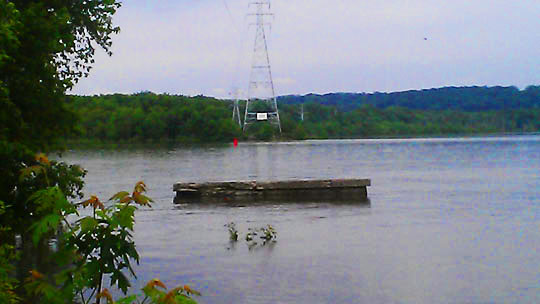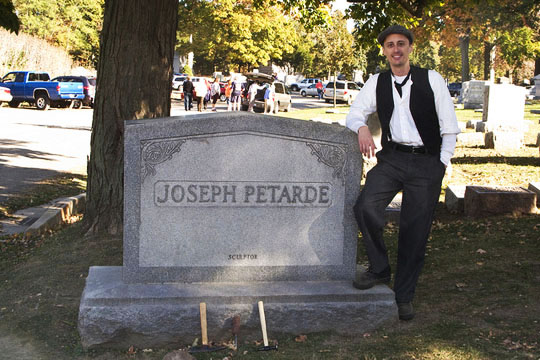One of my acting gigs every year is the Springdale Cemetery Tour presented by Prairie Folklore Theatre, which typically happens the first two weekends in October (be on the lookout for it and plan to attend later this year, there will be an announcement about it right here on MBIP!) Each year the tour selects a different section of the sprawling property and guests are able to walk and learn about notable Peorians buried at the historic Springdale site.
I’ve been a regular for several years now, and in my first year with the tour I had the pleasure of researching and portraying a most interesting individual, an artist known as “Peoria’s Forgotten Sculptor.” With a moniker like that, it’s quite possible that you’ve not heard of his name, but it’s very likely you have seen some of his work. And if you ever catch some of those great locally-produced documentaries that air on WTVP (usually during pledge time) he has been mentioned in some of them.
Joseph Petarde
The sculptor Joseph Petarde was born Joseph Petardi in Rome, Italy in 1866 into a family where the tradition of stonecarving began hundreds of years prior during the Italian Renaissance. Petarde carved his first stone sculpture at age five, and soon his father put him to work in the family business, learning techniques that had been passed down for generations. At thirteen, he accidentally damaged a sculpture he was working on and in fear of his father’s wrath, ran away to North Africa for six months. How a kid pulls off a dramatic stunt like that is beyond me, but he somehow did it.
At seventeen he traveled to Paris and carved sculptures of saints placed in churches throughout the city. Eventually he found his way to New York City to work for a bridge building company that was hired to build a bridge across the Illinois River, which is how he wound up in Peoria.
That bridge, called the Upper Free Bridge, was built near where the McClugage Bridge stands today, and if you wander the river you can actually still find remnants of the old bridge. I wandered down there to try and look for said remnants, but the recent flooding made that a challenge. Nevertheless, I think I may have found one which you can reach by turning down Lorentz Avenue…
I couldn’t get any closer. The smell was a little...overwhelming down there as well, so I retreated.
Captain Alexander Partridge, who donated the land for it, insisted that the bridge be usable free of charge (and hence, its name). Petarde lived with Captain Partridge during the bridge’s construction, and went on to marry his daughter Hannah. The Petardes moved into a home at 637 Fairholm Street, in Peoria’s Averyville, and had eight children. As the family grew, they moved down the street into a larger house at 623 Fairholm. Petarde commuted to a job in Galesburg at the Alexander King and Company Stoneyard until 1911, when King and Company went bankrupt. From there, he took a job with the Enterprise Stone Company located right in Averyville. His eldest son Clyde entered their apprenticeship program there, another stonecarver joining the “family business”.
One of their greatest projects together was their own home at 623 Fairholm Street in Averyville, and here’s the kicker—this house still exists and is a true site to be seen. To get there, turn down Fairholm (off of Adams, right at the McDonald’s).
It’s sort of a weird street that you will need to turn around on, so if you drive by, you’ll be able to easily get a second look. There’s all kinds of cool stuff to look at on this house-faces, creatures, and statues of Atlas and semi-nude women adorning the corners of the porch. Hannah Petarde, the wife, hated them and refused to use front door in protest).
There are so many other details that beg to be seen in person! I have absolutely no idea who lives there now, so I apologize to them for plastering pictures of their home all over the internet! Especially in light of that KEEP OUT sign, which is why the pics aren’t great—figured it was best to stay in my car…
Around the early 1920s, he changed the last name of Petardi to Petarde, and both spellings are still apparently in use by his descendents today. His work during this point in time covered the whole map of Central Illinois, including the Consistory in Bloomington, and in Peoria at the GAR Hall, the old courthouse and post office, the Dime Savings and Trust Company, as well as within the grounds of Springdale Cemetery.
This is the elaborate Crandell monument, located not too far from Petarde’s own burial site.
Here’s some shots of his work on the GAR Hall located downtown.
The economic climate of the 1920’s and its looming Depression decreased available construction jobs, and new inventions such as planers and diamond drills were making the work of stonecarvers obsolete. After the death of his wife Hannah in 1932, he still managed to continue working in Peoria and Bloomington, and in 1935. He was commissioned by the GAR Auxiliary to carve a gift for the state capital in Springfield—a sculpture of Abraham Lincoln. This statue was eventually vandalized and disappeared, but he also carved a smaller replica of this same sculpture as a gift to Kingman School in Peoria.
His eyesight began to fail due to cataracts which obviously would affect his work. He died on February 12, 1942 and was buried in Springdale cemetery in a plot that includes his wife and other members of his family. The plot is located right alongside the road at the Cemetery’s Mount Auburn and Lawn Division sections.
Oddly enough, in a place that includes so much of his work with other monuments (some of it very near his resting place), his own stone is deceptively plain and simple.
Most records of Petarde’s work were lost or destroyed over time, but as you’ve seen, the house on Fairholm Street still exists, as does scores of many other sculptures throughout Central Illinois and beyond!
Chip Joyce is the newest MBIP weekend contributor, check out his picture and bio here (scroll to the bottom of the page.) Welcome aboard, Chip!
Further reading: Name This Peoria Landmark, Find A Grave and Springdale Cemetary.
Bonus Photo: Chip Joyce Channels the Petarde Spirit!
Here I am when I “played” Joseph Petarde. Don’t I look Italian?


















